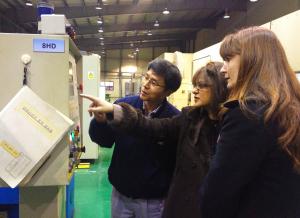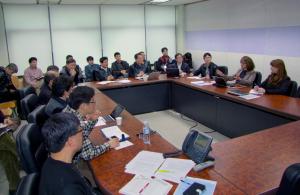Back from Korea with a "feeling of confidence"
11 Feb 2013
-
Robert Arnoux
There are several ways to ascertain whether proper safety procedures are being observed. All rely on the "safety culture" that should permeate all actions in the supplier chain.
In Ulsan, on the southeastern coast of Korea, Hyundai Heavy Industries mass produces supertankers, mammoth cruise and container ships, giant bulk carriers, and vessels of all shape, purpose and form.
The world's largest shipyard is also manufacturing part of a vessel that will never take to the sea—the ITER vacuum vessel, a 5,000-tonne, doughnut-shaped chamber that will house the fusion reaction and act as a first safety containment barrier.
Procuring two out of the nine ITER vacuum vessel sectors is part of Korea's commitment to ITER. In a workshop at the Ulsan shipyard, work has begun on the lower segment of the first of these two sections. More than 9,000 kilometres from the ITER site, one of the most critical components of the ITER Tokamak is slowly taking shape.
For Joëlle Elbez-Uzan, acting division head for Nuclear Safety, Licensing & Environmental Protection at ITER, and Sandrine Rosanvallon, safety analysis technical officer, inspecting this impressive piece of steel was one of the highlights of their recent mission to Korea—a feeling of "history in-the-making."
The invitation to Korea had been extended by Kijung Jung, head of the Korean Domestic Agency. Intended as a demonstration of Unique ITER Team spirit, it provided the nuclear safety specialists with an opportunity to share information on safety regulations and licensing procedures with their Korean colleagues and to proceed also with an internal safety inspection on the ongoing work at Hyundai Heavy Industries.
"As the nuclear operator of the ITER installation," explains Joëlle, "the ITER Organization has an obligation to monitor the manufacturing process of the components that qualify as Safety Important Components (known as SIC components). The vacuum vessel—which forms the first standing barrier between the nuclear plasma and the environment—is one of the main ITER SICs."
There are several ways to ascertain whether proper safety procedures are being observed: some rely on a close examination of the paperwork that documents the manufacturing process; others require actual on-site inspections. All rely on what Joëlle calls the "safety culture" that should permeate all actions in the supplier chain.
The vacuum vessel is an especially challenging component. It is not only a SIC, but also an ESPN—équipement sous pression nucléaire (equipment under nuclear pressure) as defined by the French nuclear safety regulations that ITER observes.
During they five-day mission to Korea, Joëlle (centre) and Sandrine shared information on safety regulations and licensing procedures with their Korean colleagues and proceeded with an internal safety inspection on the ongoing work at Hyundai Heavy Industries.
"This classification means that in-service inspections will have to be conducted during the Operation Phase of ITER," explains Joëlle. "As this will be, practically speaking, very difficult, the ITER Organization defines 'compensatory measures' at the design phase that are integrated in the component's design: rails and guides, for instance, have to be installed in the vacuum vessel wall to accommodate endoscopes and other inspection devices."
During their five-day mission Joëlle and Sandrine verified all this and much more. "In a certain sense, it was also a training exercise. The French safety authority will carry out similar on-site inspections in the course of the manufacturing phase and our Korean colleagues have to be ready for them ..."
Joëlle and Sandrine flew back to ITER with an overall feeling of confidence. "Based on the documents we reviewed, the Quality Order is well implemented and fabrication control is robust," says Joëlle. "Methods and organization are in line with what the safety regulator expects and our Korean colleagues were especially open, warm and cooperative."
"Safety culture" is definitely trickling down from the stringent French regulations all the way to the workshop in the Ulsan shipyard.



